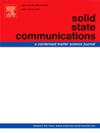Efficiency enhancement via novel lead-free inorganic CsSnBr3/Cs3Bi2I9 heterojunction absorber layer in perovskite solar cell
IF 2.1
4区 物理与天体物理
Q3 PHYSICS, CONDENSED MATTER
引用次数: 0
Abstract
In this work, we introduce a novel simulation approach that leverages the potential of a lead-free CsSnBr3/Cs3Bi2I9 perovskite heterojunction as the absorber layer, integrated into a high-performance all-inorganic device architecture consisting of FTO/TiO2/Absorber/CuSCN/Au. This approach aims to extend the absorption range of the solar spectrum. It allows for comparing single-junction devices with Cs3Bi2I9 as the absorber layer, helping to assess improvements in photovoltaic parameters. When the device utilizing Cs3Bi2I9 as the absorber layer was simulated under constant parameters, it demonstrated impressive performance metrics, achieving an open-circuit voltage of 1.33 V, a short-circuit current density of 11.56 mA/cm2, a fill factor of 61.12 %, and a power conversion efficiency of 9.42 %. In contrast, when the heterojunction CsSnBr3/Cs3Bi2I9 absorber layer was used, a notable improvement in photovoltaic parameters was observed, with a VOC of 1.32 V, JSC of 19.76 mA/cm2, and FF of 68.2 %, resulting in a PCE of 17.81 %. This indicates a significant enhancement in the performance of solar cell devices. We also investigated the combined effects of the thickness of the bi-absorber layer and defect density using contour plots. The defects at the CsSnBr3/Cs3Bi2I9 interface, series and shunt resistance, capacitance and Mott-Schottky behaviour, charge generation and recombination, and temperature were studied to understand the impact of these parameters on perovskite solar cells device performance. Overall, this work explores the advantages of the CsSnBr3/Cs3Bi2I9 heterojunction absorber layer approach, which opens new pathways for researchers to improve the performance of inorganic PSCs.

新型无铅无机CsSnBr3/Cs3Bi2I9异质结吸收层提高钙钛矿太阳能电池效率
在这项工作中,我们引入了一种新的模拟方法,利用无铅CsSnBr3/Cs3Bi2I9钙钛矿异质结作为吸收层的潜力,将其集成到由FTO/TiO2/吸收器/CuSCN/Au组成的高性能全无机器件架构中。这种方法旨在扩大太阳光谱的吸收范围。它允许将单结器件与Cs3Bi2I9作为吸收层进行比较,有助于评估光伏参数的改进。采用Cs3Bi2I9作为吸收层的器件在恒定参数下进行仿真,其性能指标令人印象深刻,开路电压为1.33 V,短路电流密度为11.56 mA/cm2,填充系数为61.12%,功率转换效率为9.42%。相比之下,当使用异质结CsSnBr3/Cs3Bi2I9吸收层时,光伏参数得到了显著改善,VOC为1.32 V, JSC为19.76 mA/cm2, FF为68.2%,PCE为17.81%。这表明太阳能电池装置的性能有了显著的提高。我们还利用等高线图研究了双吸收层厚度和缺陷密度的综合影响。研究了CsSnBr3/Cs3Bi2I9界面缺陷、串联和分流电阻、电容和Mott-Schottky行为、电荷产生和重组以及温度等参数对钙钛矿太阳能电池器件性能的影响。总的来说,本工作探索了CsSnBr3/Cs3Bi2I9异质结吸收层方法的优势,为研究人员提高无机psc的性能开辟了新的途径。
本文章由计算机程序翻译,如有差异,请以英文原文为准。
求助全文
约1分钟内获得全文
求助全文
来源期刊

Solid State Communications
物理-物理:凝聚态物理
CiteScore
3.40
自引率
4.80%
发文量
287
审稿时长
51 days
期刊介绍:
Solid State Communications is an international medium for the publication of short communications and original research articles on significant developments in condensed matter science, giving scientists immediate access to important, recently completed work. The journal publishes original experimental and theoretical research on the physical and chemical properties of solids and other condensed systems and also on their preparation. The submission of manuscripts reporting research on the basic physics of materials science and devices, as well as of state-of-the-art microstructures and nanostructures, is encouraged.
A coherent quantitative treatment emphasizing new physics is expected rather than a simple accumulation of experimental data. Consistent with these aims, the short communications should be kept concise and short, usually not longer than six printed pages. The number of figures and tables should also be kept to a minimum. Solid State Communications now also welcomes original research articles without length restrictions.
The Fast-Track section of Solid State Communications is the venue for very rapid publication of short communications on significant developments in condensed matter science. The goal is to offer the broad condensed matter community quick and immediate access to publish recently completed papers in research areas that are rapidly evolving and in which there are developments with great potential impact.
 求助内容:
求助内容: 应助结果提醒方式:
应助结果提醒方式:


